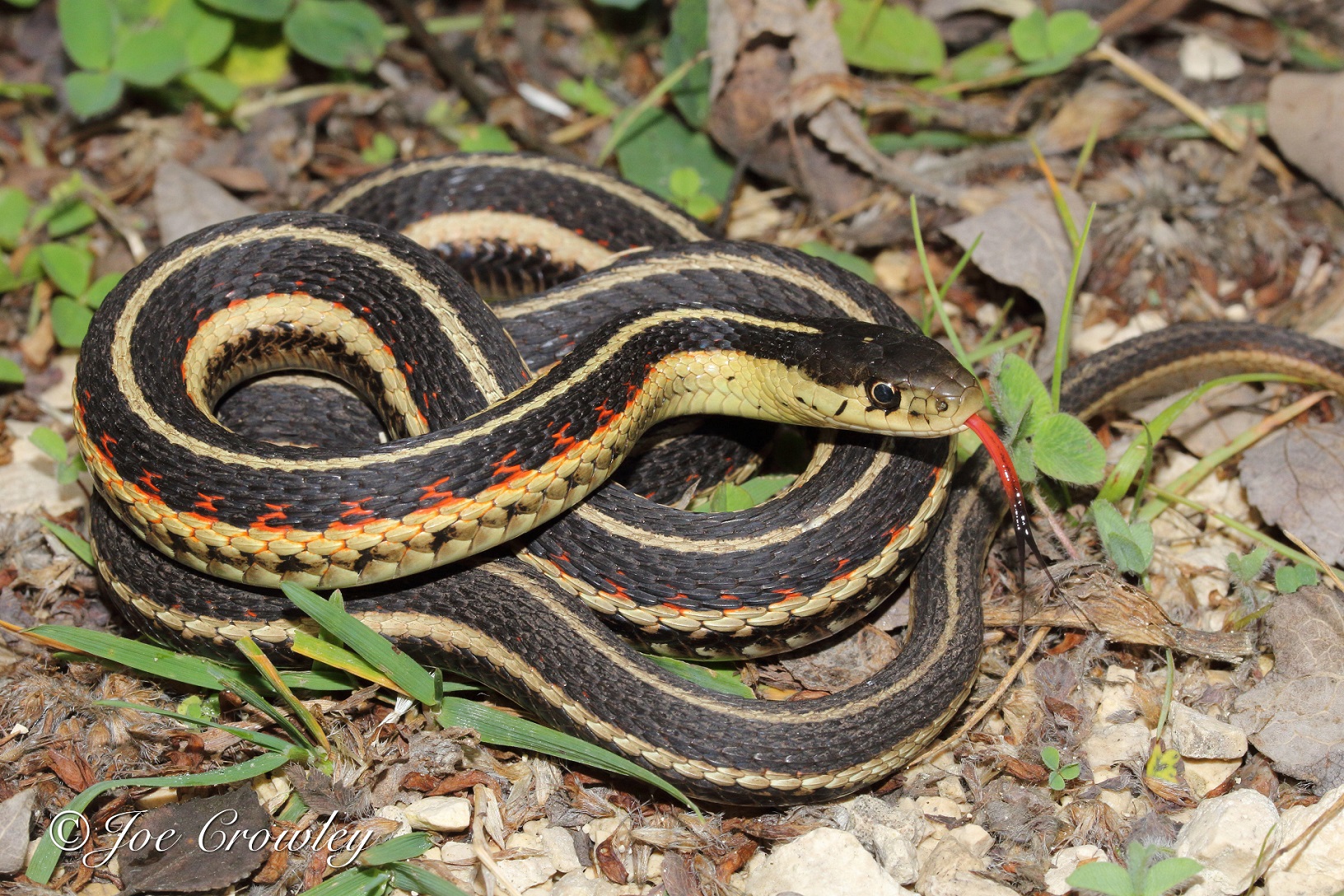
Description
The common gartersnake is a small- to medium-sized snake that can reach a total length of 1.37 m, although few individuals attain sizes larger than 90 cm. Females are larger than males. The scales are “keeled,” meaning each scale has a central ridge, giving the snakes a rough look and feel. Individuals are greenish, greyish brown or black, and typically have three stripes that run from the neck to the tip of the tail. One stripe runs down the middle of the snake’s back and the other two along each of its sides on the second and third scale rows. In gartersnakes found in Canada, the stripes are usually yellow to cream coloured. The chin and belly are also usually cream coloured or pale yellow, but can sometimes be whitish, grey or greenish.

Colour and pattern vary across subspecies and even among individuals of the same subspecies. The Maritime gartersnake tends to have poorly defined stripes, black spots that form a checkered pattern, and light flecking along its sides. By comparison, the Eastern gartersnake usually has well-defined stripes. It also has alternating dark spots that form a checkered pattern, although these spots may not be apparent on darker individuals. Melanistic individuals, which lack stripes and are solid black on the sides and back, are common in some parts of the Eastern gartersnakes’ range. Red-sided and valley gartersnakes have prominent red or orange bars between their stripes. On the valley gartersnake, the stripe down its back is well-defined and bright yellow. The Puget Sound gartersnake is typically black with less prominent red bars between its stripes, which are yellow, pale green or blueish grey.
Did you know?
In addition to the common gartersnake, four other species of gartersnake are found in Canada: Butler’s gartersnake (Thamnophis butleri), the terrestrial gartersnake (Thamnophis elegans), the Northwestern gartersnake (Thamnophis ordinoides), and the Plains gartersnake (Thamnophis radix).

Distribution and Habitat
The Maritime gartersnake is found throughout Prince Edward Island, Nova Scotia, New Brunswick and Southern Quebec. Moving west, the Eastern gartersnake is found in Western Quebec, throughout Southern and Central Ontario, and in Northern Ontario as far north as the southern shore of James Bay. The red-sided gartersnake has an extensive Canadian distribution, from Northwestern Ontario to Eastern British Columbia and north into a small portion of the Northwest Territories. The valley gartersnake is found throughout Southern and Central British Columbia. Elsewhere in British Columbia, the Puget Sound gartersnake has a restricted range, limited to Vancouver Island, the Gulf Islands and the adjacent mainland Coast. In the United States, the common gartersnake is found in all states except Arizona, although it has a limited distribution in most southwestern states.
The common gartersnake is a habitat generalist. This means it can be found in a variety of habitats across its Canadian range, including wetlands, grasslands, savannah, forest, shorelines of lakes and rivers, rocky outcrops, and mountain slopes. They also use human-modified areas, such as old fields, roadside ditches and urban parks. Common gartersnakes tend to be most common near aquatic habitats such as wetlands, lakes and rivers, likely because their food, in particular amphibians, is also more abundant there. Individuals spend the winter hibernating underground in places like rock crevices, mammal burrows, root hollows or the foundations of old buildings. These locations allow the snakes to get below the frost line and avoid freezing temperatures. Because suitable hibernation sites are sometimes limited, common gartersnakes typically hibernate communally, often in groups of hundreds or even thousands of individuals.
Did you know?
Canada is home to the largest known congregations of snakes anywhere in the world. In spring and fall, over 50,000 red-sided gartersnakes congregate at hibernation sites in the Narcisse Wildlife Management Area in Manitoba. This natural spectacle has made Narcisse a world-renowned tourist destination.

Reproduction and Development
Common gartersnakes typically mate in the early spring, right after they’ve emerged from hibernation. Males remain near the hibernation site to mate with females as they emerge and disperse. Multiple males will attempt to mate with a single female, sometimes forming large “mating balls.” Males reach sexual maturity at one to two years of age, and females at two to three years of age. After reaching sexual maturity, females reproduce every one to three years, although they rarely reproduce in consecutive years at the northern extent of their range. On average, females give birth to 27 young. Litters in Western Canada are smaller than those in Eastern Canada. In Canada, the young are typically born in July, August or September. There is little information available on the lifespan of this species in the wild, but in one Canadian population scientists documented several individuals that lived for at least six years.

Diet and Predation
Common gartersnakes are usually diurnal, meaning they are active during the day. They hunt by searching for and following the scent of their prey. Common gartersnakes primarily eat amphibians and earthworms, but they also consume a variety of other prey, including insects, spiders, leeches, slugs, snails, crayfish, mice, fish, other snakes, and occasionally small birds and bird eggs. Common gartersnakes have numerous predators and are eaten by a wide range of mammals (e.g., raccoons, coyotes, chipmunks, shrews), birds (e.g., hawks, crows), fish, snakes, lizards, turtles, amphibians and invertebrates (e.g., spiders, crayfish).

Status and Threats
Globally, the common gartersnake is listed as “least concern” by the International Union for the Conservation of Nature. Since the species is widespread and abundant in Canada, its status has not been formally assessed by the Committee on the Status of Endangered Wildlife in Canada. Habitat loss and the death of individuals on roads are the most significant threats to this species. The loss of hibernation sites can be especially detrimental since individuals congregate in large numbers at these sites.

 Share on Facebook
Share on Facebook Share on X
Share on X Share by Email
Share by Email Share on Google Classroom
Share on Google Classroom



